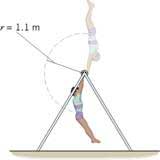| |||
| Math Central | Quandaries & Queries |
|
|
Hi William.
The gravitational force does work on the gymnast which becomes kinetic energy. This work is conserved. Therefore you can equate the loss in gravitational potential energy to the kinetic energy of the gymnast at the bottom of the loop.

His gravitational potential energy change is mgh, where g is the gravitational acceleration on earth (presumably!), h is the change in height of his center of mass and m is the gymnast's mass.
His kinetic energy at the bottom of the loop is (1/2)mv2. As described in the problem, all the GPE was transformed into kinetic motion, so:
mgh = (1/2)mv2
Can you solve for v and substitute the known values for g and h to get the velocity?
Stephen La Rocque.>
 |
||
Math Central is supported by the University of Regina and The Pacific Institute for the Mathematical Sciences.